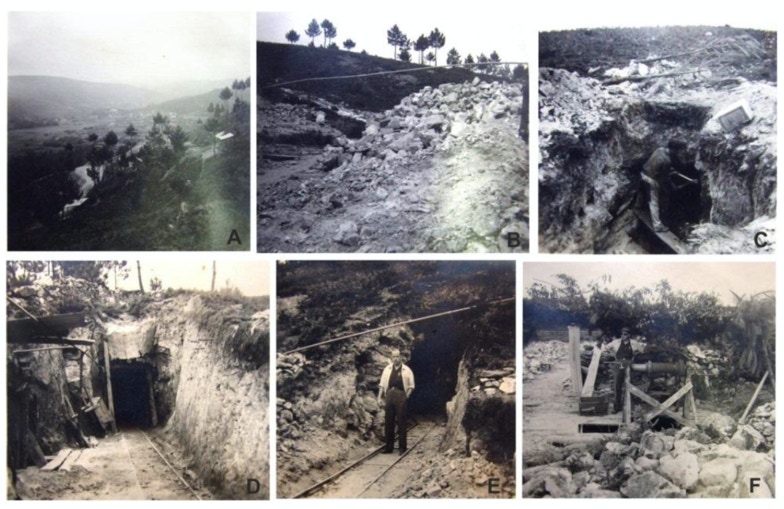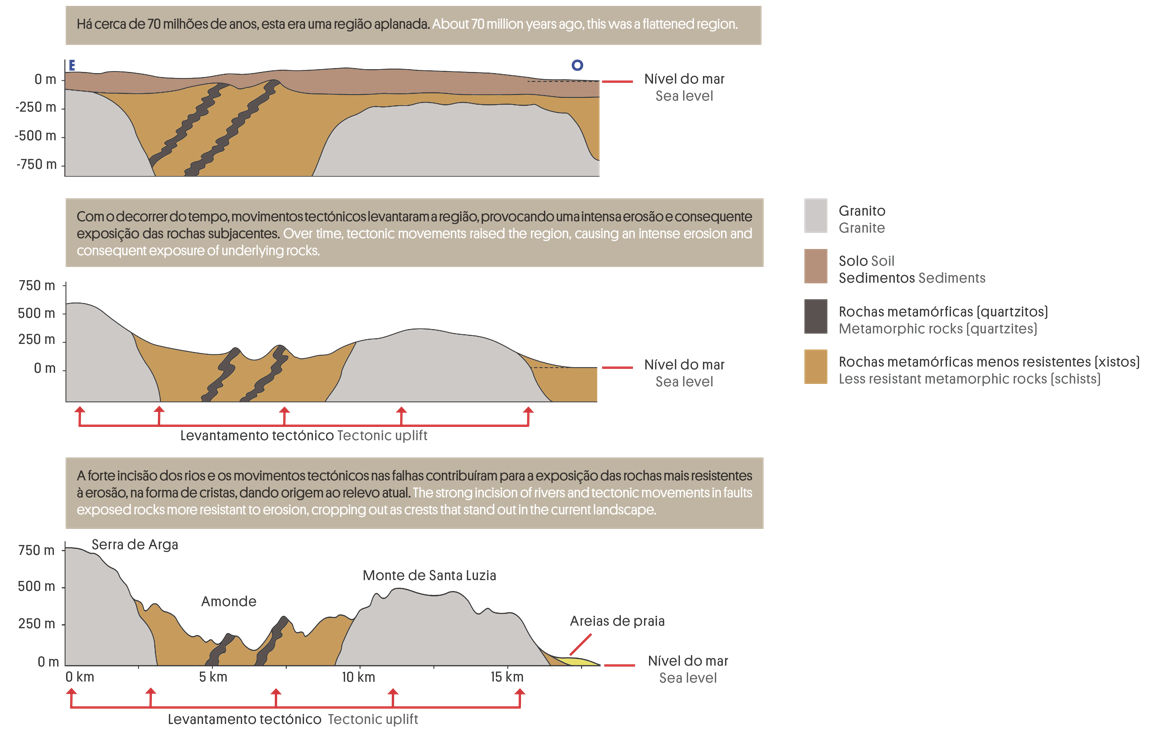Mineral deposits
Mineral deposits are natural concentrations rich in certain chemical elements that can be important from the economic point of view. Mineral deposits might have different origins related to magmatic, metamorphic or sedimentary processes. They are organised as syngenetic when their origin is contemporaneous of the mother rock, and epigenetic when it occurs after the mother rock was formed.
Mineral deposits existing in this LNM are of syngenetic-type. They were formed when hydrothermal fluids circulated through rock fractures during the last stages of crystallization of granitic rocks (Fig. 5.1).
Hydrothermal fluids are essentially hot water that exists in depth and contains minerals and other chemical compounds dissolved from the rocks through which it passes or from the cooling magma. As these fluids cool down, they release the dissolved chemical compounds and originate mineral deposits. In the area of the LNM and surroundings there are mineral deposits containing gold, silver, tungsten (wolfram), and tin (cassiterite).

Figure 5.1. Formation of mineral deposits associated with magmatic rocks.
Economic exploitation of mineral deposits
The existence of mineral deposits in a given region does not necessarily mean that they can be economically exploited because this depends on several factors. Natural aspects, such as the type of geological formation where the deposits are located, and climate may be a serious conditioning. On the other hand, the very characteristics of the deposits and especially the concentration of chemical elements are determining: usually, higher concentrations make exploitation more profitable. The deposits must also be large enough otherwise costs related to the transportation and use of technology and equipment become unbearable.
The way in which mineral deposits are exploited is also significant: in general, the exploitation in quarries is cheaper than underground mining. The mean value of the workers’ wages must also be taken into account.
The exploitation of mineral deposits depends on the economic use given to those materials that are taken from them. Social and cultural changes usually imply different needs of raw materials leading to the rise on the demand of certain minerals (Fig. 5.2). Mineral resources are thus a commodity with a high commercial and strategic value, and their market price may vary greatly depending on supply and demand and on the existence of commercial treaties between countries.

Figure 5.2. To make a mobile phone is necessáry 10 to 15 kg of ore that contains a high concentration of gold, 1 kg of copper ore, 750 g of ore rich in tungsten, and 200 g of nickel ore.
This set of factors makes mining activity extremely dynamic both in space and time. Certain regions might prosper during certain years but economic decline might happen if the mining activity decreases or is interrupted.
Geomining heritage
Human population always depended on the use of rocks and minerals for its own survival. Traces of historical mining are a valuable heritage since it gives us information on the habits and activities of ancient communities. These traces are named mining heritage and they may be quite diverse: equipment and buildings, graphic records, written and oral testimony, changes in the landscape, quarries and mining galleries, mine waste dumps, and others. Sometimes, rocks and minerals that have been exploited can be found along with these traces; when this happen we call it geomining heritage. Geomining heritage is quite often associated with industrial heritage, particularly when remaining mining equipment and facilities still exist. In Portugal, traces connected to the exploitation of gold by Romans, and more recently to the exploitation of wolfram in the middle of the 20th century are quite common in certain regions (Fig. 5.3).
Due to environmental, social and visual impacts, traces of ancient mining are many times considered as negative. However, this situation is slowly changing and mining traces are becoming more and more considered as a promising educational and touristic resource which can bring economic and social revenue to local communities.
In the Iberian Peninsula, for instance, there are some interesting examples concerning the recovery of geomining heritage. In Spain, the mining area of Las Médulas is part of the UNESCO World Heritage List since 1997 receiving thousands of visitors every year. In Portugal, the mineral pyrite was exploited in the Lousal mines for almost the entire 20th century. In 1988, the mining activity stopped and a touristic and educational project was implemented in the region which is changing the life of local communities. This project is part of the Portuguese network Centros de Ciência Viva.

Figure 5.3. Photographs of mining works in the Alto da Bouça da Breia mine, 1957: A – General view of the region and mining facilities; B – Mine waste dump; C – Shaft; D – Mining gallery in a in pegmatite vein; E - Mining gallery in pegmatite vein; F – Shaft in gold vein (Dossier 3146, RRM, 1957) (Archive of the General Board of Energy and Geology).
5.2. Weathering and relief
There are three types of weathering: physical, chemical and biological. During physical weathering, sediments in rivers, beaches and deserts, for instance, break up and become progressively rounded due to collision between them. The development of fractures in rocks is also important in physical weathering. Fractures allow the circulation of fluids, in particular water, in the rock. The closer the network of fractures, the greater the amount of water that circulates, leading to more intense weathering. Sometimes, minerals form from the circulating water and put pressure on the rock as they grow, contributing to the enlargement of fractures. On the other hand, when water freezes in the fractures, its volume increases about 9%. This also increases pressure on the fracture, which enlarges. When water becomes liquid again, it penetrates in the new open spaces and progressively alters the rock as a result from the successive cycles of freezing and melting. Heat also favours physical weathering, particularly in deserts, once extreme temperature variations between day and night take place and might contribute to the origin of fractures in rocks. When plants grow, the volume of their roots in fractures increases, and this also contributes to their enlargement.
Chemical weathering is the result of chemical reactions between the minerals that form the rocks and the water and gases that are present in the atmosphere. Not all minerals react similarly because they chemical composition and crystalline structure are different. Iron minerals, for instance, tend to oxidize quickly in the presence of water and oxygen leading to changes in their physical and chemical properties. Climate also greatly influences chemical weathering because chemical reactions are faster in higher temperatures and the existence of abundant water. Thus, chemical weathering is more significant in humid tropical climates than in cold regions.
Living organisms in rock fractures and at their surface can be responsible for the existence of certain chemical compounds that contribute to chemical weathering. The outcome of physical and chemical alteration caused by living organisms is called biological weathering.
Rocks that are subjected to weathering become fragile and are dismantled in a process called erosion. Weathering and erosion are distinct but complementary processes. Weathering favours erosion, and in its turn, erosion contributes to expose new rock surfaces to weathering.

The relief in this LNM
As already mentioned, there are multiple factors that contribute to weathering. In rocks constituted by harder minerals, weathering is usually slower and therefore they are more prominent in the landscape (Fig. 5.4). Such is the case of quartzites; these metamorphic rocks are almost constituted by quartz which is highly resistant to weathering. In this LNM, metamorphic rocks give rise to aligned landforms with a NW-SE direction that stand out in the landscape (Fig. 5.5).
Figura 5.4. Mapa evidenciando o relevo geral da região. Na zona a norte do MNL são evidentes os relevos alinhados (cristas) correspondendo a rochas metamórficas mais resistentes à erosão.

Figura 5.5. Evolução do relevo na zona do MNL durante os últimos 70 milhões de anos.









